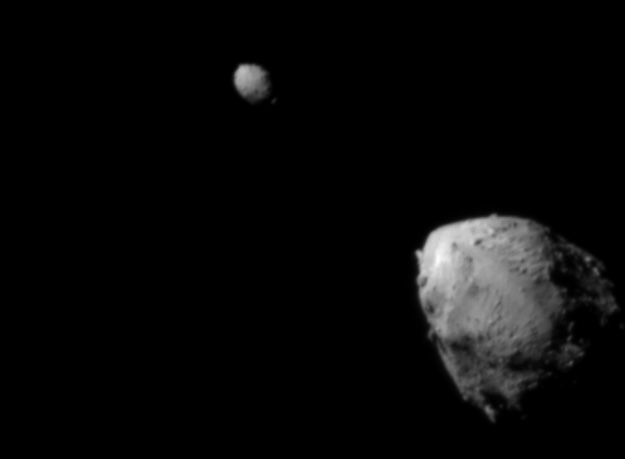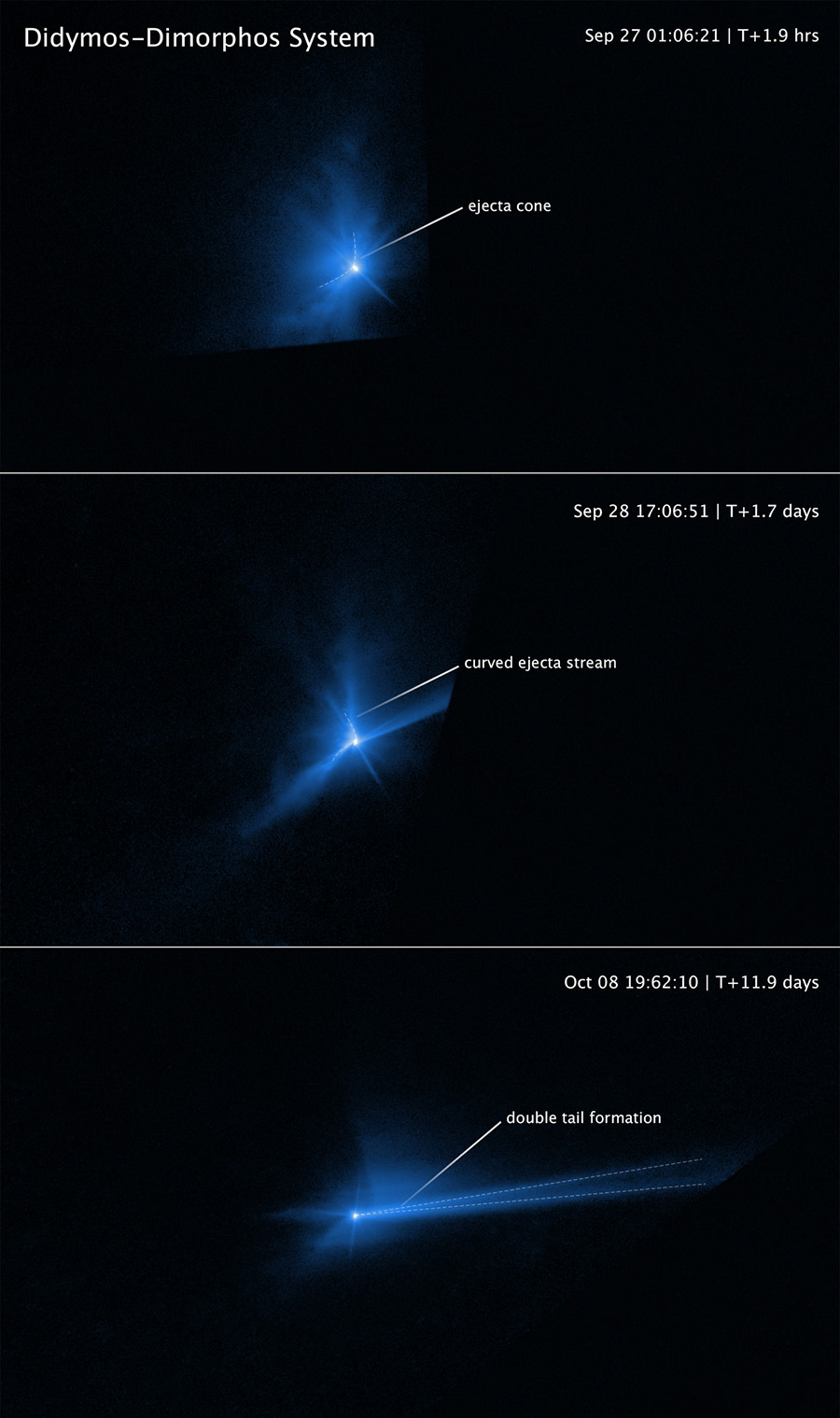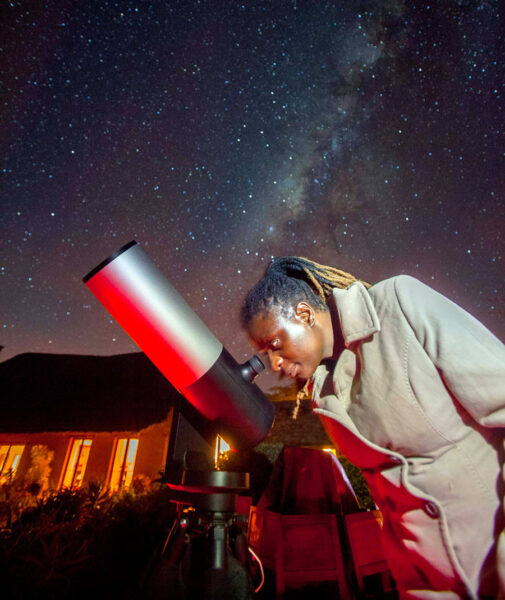From - Sky & Telescope,
By Lauren Sgro
Edited by -Amal Udawatta

NASA / Johns Hopkins APL
Last year, NASA intentionally crashed the Double Asteroid Redirection Test (DART) into a nearby asteroid to test our ability to defend the Earth from rocky threats. The results are now in – the DART mission was a smashing success.
On September 26, 2022, DART hit its target asteroid Dimorphos, moon of the nearby asteroid 65803 Didymos, in a historic celestial experiment. Not only was DART the first planetary defense mission of its kind, but it marked the first time humanity was able to change the motion of a natural object in space. Initial estimations showed that Dimorphos’ orbit shortened by 32 minutes due to the impact, proving a successful deflection.
Now, five papers published March 1st in Nature detail more about the collision’s aftermath, from the mass of the dust jettisoned from Dimorphos’ surface to the momentum transferred from the impact.
DIMORPHOS SHIFTED WHEN DART HIT
A team led by Terik Daly (Johns Hopkins Applied Physics Laboratory) used ground-based radar observations and images from DART’s onboard camera to model the shape of Dimorphos and recreate the moment of impact. Using these data, they make the first estimate of Dimorphos’ density: 2,100 to 2,700 kg per cubic meter. That’s roughly half the density of Earth, indicating the moonlet’s rubble-pile nature.

Scence: NASA / ESA / STScI, Jian-Yang Li (PSI); Image processing: Joseph DePasquale (STScI)
In the same vein, a team led by Christine Thomas (Northern Arizona University) used visible-light and radar data to narrow down the change in Dimorphos’ orbital period around the larger Didymos to be 33 minutes, give or take 1 minute. Previous measurements had an uncertainty of 2 minutes, so this is the most precise measurement yet.
These characterizations of Dimorphos allowed Andrew Cheng (also at Johns Hopkins APL) and colleagues to simulate the change in Dimorphos’ velocity along its orbit. From these calculations, they assessed the momentum transferred to the unsuspecting asteroid during the collision.
Cheng’s team showed that the material knocked from Dimorphos’ surface during impact ended up transferring more momentum to Dimorphos than the DART spacecraft did by itself. Using LICIACube images, they find that the ejecta plume followed a direction nearly opposite and away from that of DARTs impact. That opposite reaction pumped more momentum into the system to bolster DART’s effect by 3.61 times, nudging Dimorphos into a new orbit.
“There were predictions of both high and low momentum transfer, so I can’t say I was very surprised, but I was expecting to see a lower momentum transfer [from the ejecta],” says Cheng, who is DART’s principal investigator.
CITIZEN SCIENTISTS CONTRIBUTE TO DART
Observers at large telescopes weren’t the only ones watching the DART impact. In a study led by Ariel Graykowski (SETI Institute), a light curve shows Dimorphos’ changes in brightness and color before, during, and after the impact — all made possible by the 31 citizen scientists who are listed as coauthors on the paper.

Susan Murabana
These observers, located across five continents, submitted data using their Unistellar eVscopes as part of Unistellar’s partnership with the SETI institute. Several of these avid skywatchers even caught the moment of impact.
Using the brightness measurements gathered by amateur astronomers, Graykowski’s team estimated the mass, speed, and energy of the ejecta. “Cheng and colleagues quantify exactly how much extra momentum the dusty ejecta must have transferred to the asteroid,” Graykowski says. “Our estimates from ground-based observations taken with small, 4.5-inch telescopes are in agreement.”
Graykowski and colleagues used the eVscope data to track the movement of the ejecta, and they calculated that the ejecta mass was only 0.3 to 0.5% of Dimorphos’ total mass. Despite the bright display of mass loss post-impact, this estimate confirms that the cosmic crash didn’t destroy Dimorphos.

SETI Institute
Although the collision was not destructive, Jiang-Yiang Li (Planetary Science Institute) and his collaboration find that it did turn Dimorphos into an active asteroid with a tail and coma — like a comet but without the sublimating ice. Previously, astronomers suspected that natural impacts could make asteroids active, but no one had observed such an impact directly. Dimorphos’ newfound activity confirms this idea and gives scientists a real-life laboratory to study how it works.
THE FUTURE OF PLANETARY DEFENSE
DART has made an impact on our understanding of asteroids and how we will guard Earth in the future, proving that we aren’t doomed to become the victims of a movie plot. Now that we have seen a kinematic impactor (that is, the DART mission) result in successful deflection, this method of planetary defense has moved from a theoretical possibility to a viable option to save our planet.
We will learn more about the post-impact Didymos system with the European Space Agency’s Hera Mission. Scheduled to launch October 2024, Hera will characterize and probe the surface of Dimorphos upon its arrival in 2026. “Most important is that Hera will measure the mass of Dimorphos,” notes Cheng. “Hera will also measure the size of the DART crater and measure the deformation, if any, of Dimorphos. These are critical data to better determine the amount of ejecta.”
Comments
Post a Comment